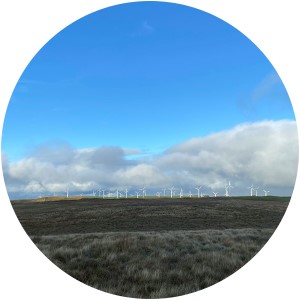
The UK government plans to ‘Build Back Greener’ and make the UK the world leader in clean wind energy. Any impacts of wind farms on the water environment must be minimised.
How wind farms can affect the water environment
The construction and operation of wind farms can have impacts on:
- water quality
- flood risk
- water quantity
- private water supplies
- wetlands (groundwater dependent terrestrial ecosystems, or GWDTE)
- peat
Assessing the impacts of wind farms
Environmental Impact Assessments (EIAs) are a compulsory part of the planning and consent for wind farms under the Town and Country Planning Regulations 2017 (the ‘EIA Regulations’).
Each EIA:
- assesses the current environmental conditions (natural, physical and human) at a proposed site
- identifies the potential impacts of a development (ecological receptors) on that environment
- suggests mitigation measures where appropriate.
Potential impacts on the water environment form a key part of EIAs.
Key stages of assessment
1 Assessing the current (baseline) environment
The baseline environment is assessed through a combination of desk-based studies and site visits.
WHS have experience in:
- conducting site visits to identify private water supplies close to proposed developments
- completing peat surveys to determine the extent and composition of peat within sites
2 Identifying potential impacts
The construction phase is given particular emphasis, because excavation of material and ground disturbance from infrastructure development may lead to increased erosion and sedimentation. This can result in increased sediment in surrounding watercourses.
Where peat is identified, it is important to consider the potential increase in acidic runoff due to ground disturbance. This may have impacts on both surrounding habitats and private water supplies.
Flood risk is also assessed, to ensure the development avoids areas at risk of flooding and does not cause an increase in flood risk downstream.
Flood risk is usually managed with sustainable drainage systems designed to mimic the site’s natural runoff. Minimising the artificial routing of water in this way minimises any increases in erosion and sediment runoff.
3 Suggesting appropriate mitigation
Options to reduce the impact of a development on the baseline environment should be explored. Examples include:
- using sustainable drainage systems
- locating the development away from private water supplies and water courses
- implementing on-site action plans to prevent pollution of watercourses during construction.
WHS and wind farm EIAs
EIAs are an iterative process, requiring good communication and engagement with local councils and stakeholders.
We believe in early liaison with all interested parties to ensure buy-in to the proposed EIA approach and assessment of potential impacts, so that appropriate mitigation is put in place and impacts are reduced.
We have provided input at various stages in the EIA process to over 60 wind farm developments across the UK.
This has included:
- completing EIA chapters assessing the baseline water environment, potential impacts and mitigation measures
- providing expert witness services at public inquiries for large wind farms in Wales and Scotland
- providing expert witness services for private water supply assessments on impacts on the water environment.
The last word
Cairn Duhie wind farm, near Nairn, Scotland
WHS has been working on the hydrology, hydrogeology and geology aspect of the EIA for the proposed Cairn Duhie wind farm since 2016. Our involvement has spanned multiple site redesigns and has included expert witness services at a public hearing regarding the EIA findings in relation to private water supplies.
In 2020 we completed the final amendments to the EIA chapters supporting the final design layout of Cairn Duhie. The EIA is expected to be submitted later this year.